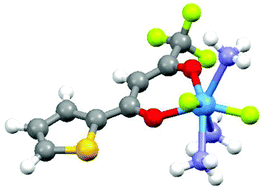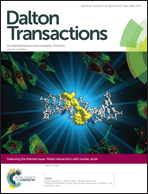Synthesis and spectroscopic properties of luminescent tantalum(v)-β-diketonate complexes and their use as optical sensors and the preparation of nanostructured Ta2O5
Abstract
This work proposes a simple and inexpensive method to prepare a new series of β-diketonate-tantalum complexes. The method is based on the use of a [TaF7]2− solution, as the tantalum precursor, thenoyltrifluoroacetone (TTA), hexafluoroacetylacetone (HFA), and benzoyltrifluoroacetylacetone (BFA) in basic medium; basic pH is achieved by adding urea to the reaction medium. Elemental analysis, H1-NMR spectroscopy, potentiometric measurements conducted with a fluorine-selective electrode, conductivity measurements, vibrational spectroscopy based on quantum chemistry calculations, and electronic spectroscopy helped in determining the molecular structure of the complexes. At room temperature in the solid state and in solution upon irradiation with UV light, the complexes exhibited blue emission, probably as a result of the heavy atom effect. On the basis of the structures, luminescence properties at room temperature, and solvent-dependent changes in the electronic properties of the complexes, these β-diketonates are potentially applicable as optical ethanol or humidity sensors and are promising materials for the development of luminescent devices.


 Please wait while we load your content...
Please wait while we load your content...